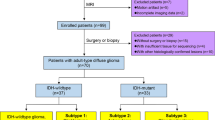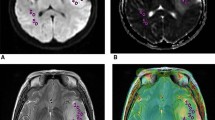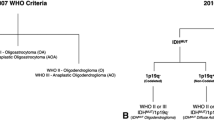Abstract
Purpose
Diffuse lower grade gliomas (LGG) with isocitrate dehydrogenase (IDH) gene mutations (IDHMUT) have a distinct survival advantage compared with IDH wild-type (IDHWT) cases but the mechanism underlying this disparity is not well understood. Diffusion Tensor Imaging (DTI) has identified infiltrated non-enhancing tumor regions that are characterized by low isotropic (p) and high anisotropic (q) diffusion tensor components that associate with poor survival in glioblastoma. We hypothesized that similar regions are more prevalent in IDHWT (vs. IDHMUT) LGG.
Methods
p and q maps were reconstructed from preoperative DTI scans in N = 41 LGG patients with known IDH mutation and 1p/19q codeletion status. Enhancing and non-enhancing tumor volumes were autosegmented from standard (non-DTI) MRI scans. Percentage non-enhancing tumor volumes exhibiting low p and high q (Vinf) were then determined using threshold values (p = 2 × 10−3mm2/s, q = 3 × 10–4 mm2/s) and compared between IDHWT and IDHMUT LGG, and between IDHMUT LGG with and without 1p/19q codeletion.
Results
Vinf volumes were significantly larger in IDHWT LGG than in IDHMUT LGG (35.4 ± 18.3% vs. 15.9 ± 7.6%, P < 0.001). Vinf volumes did not significantly differ between IDHMUT LGG with and without 1p/19q codeletion (17.1 ± 9.5% vs. 14.8 ± 5.8%, P = 1.0).
Conclusion
IDHWT LGG exhibited larger volumes with suppressed isotropic diffusion (p) and high anisotropic diffusion (q) which reflects regions with increased cell density but non-disrupted neuronal structures. This may indicate a greater prevalence of infiltrative tumor in IDHWT LGG.



Similar content being viewed by others
References
Network TCGAR (2015) Comprehensive, integrative genomic analysis of diffuse lower-grade gliomas. N Engl J Med 372(26):2481–2498
Eckel-Passow JE, Lachance DH, Molinaro AM, Walsh KM, Decker PA, Sicotte H et al (2015) Glioma groups based on 1p/19q, IDH, and TERT promoter mutations in tumors. N Engl J Med 372(26):2499–2508
Ceccarelli M, Barthel FP, Malta TM, Sabedot TS, Salama SR, Murray BA et al (2016) Molecular profiling reveals biologically discrete subsets and pathways of progression in diffuse glioma. Cell 164(3):550–563
Wijnenga MMJ, French PJ, Dubbink HJ, Dinjens WNM, Atmodimedjo PN, Kros JM et al (2018) The impact of surgery in molecularly defined low-grade glioma: an integrated clinical, radiological, and molecular analysis. Neuro Oncol 20(1):103–112
Beiko J, Suki D, Hess KR, Fox BD, Cheung V, Cabral M et al (2014) IDH1 mutant malignant astrocytomas are more amenable to surgical resection and have a survival benefit associated with maximal surgical resection. Neuro Oncol 16(1):81–91
Price SJ, Jena R, Burnet NG, Hutchinson PJ, Dean AF, Peña A et al (2006) Improved delineation of glioma margins and regions of infiltration with the use of diffusion tensor imaging: an image-guided biopsy study. Am J Neuroradiol 27(9):1969–1974
Price SJ, Jena R, Burnet NG, Carpenter TA, Pickard JD, Gillard JH (2007) Predicting patterns of glioma recurrence using diffusion tensor imaging. Eur Radiol 17(7):1675–1684
Bette S, Huber T, Gempt J, Boeckh-Behrens T, Wiestler B, Kehl V et al (2017) Local fractional anisotropy is reduced in areas with tumor recurrence in glioblastoma. Radiology 283(2):499–507
Park YW, Han K, Ahn SS, Choi YS, Chang JH, Kim SH et al (2018) Whole-tumor histogram and texture analyses of DTI for evaluation of IDH1-Mutation and 1p/19q-codeletion status in world health organization grade II gliomas. Am J Neuroradiol 39(4):693–698
Xiong J, Tan W, Wen J, Pan J, Wang Y, Zhang J et al (2016) Combination of diffusion tensor imaging and conventional MRI correlates with isocitrate dehydrogenase 1/2 mutations but not 1p/19q genotyping in oligodendroglial tumours. Eur Radiol 26(6):1705–1715
Peña A, Green HAL, Carpenter TA, Price SJ, Pickard JD, Gillard JH (2006) Enhanced visualization and quantification of magnetic resonance diffusion tensor imaging using the p : q tensor decomposition. Br J Radiol 79(938):101–109
Ellingson BM, Malkin MG, Rand SD, Connelly JM, Quinsey C, LaViolette PS et al (2010) Validation of functional diffusion maps (fDMs) as a biomarker for human glioma cellularity. J Magn Reson Imaging 31(3):538–548
Gupta RK, Cloughesy TF, Sinha U, Garakian J, Lazareff J, Rubino G et al (2000) Relationships between choline magnetic resonance spectroscopy, apparent diffusion coefficient and quantitative histopathology in human glioma. J Neurooncol 50(3):215–226
Sugahara T, Korogi Y, Kochi M, Ikushima I, Shigematu Y, Hirai T et al (1999) Usefulness of diffusion-weighted MRI with echo-planar technique in the evaluation of cellularity in gliomas. J Magn Reson Imaging 9(1):53–60
Price SJ, Peña A, Burnet NG, Jena R, Green HAL, Carpenter TA et al (2004) Tissue signature characterisation of diffusion tensor abnormalities in cerebral gliomas. Eur Radiol 14(10):1909–1917
Mohsen LA, Shi V, Jena R, Gillard JH, Price SJ (2013) Diffusion tensor invasive phenotypes can predict progression-free survival in glioblastomas. Br J Neurosurg 27(4):436–441
Price SJ, Lupson VC, Yan J-L, Boonzaier NR, Larkin TJ, Liu H et al (2016) Less invasive phenotype found in isocitrate dehydrogenase–mutated glioblastomas than in isocitrate dehydrogenase wild-type glioblastomas: a diffusion-tensor imaging study. Radiology 283(1):215–221
Li C, Wang S, Yan J-L, Piper RJ, Liu H, Torheim T et al (2018) Intratumoral heterogeneity of glioblastoma infiltration revealed by joint histogram analysis of diffusion tensor imaging. Neurosurgery. https://doi.org/10.1093/neuro/nyy388
Capper D, Weissert S, Balss J, Habel A, Meyer J, Jäger D et al (2010) Characterization of R132H mutation-specific IDH1 antibody binding in brain tumors. Brain Pathol 20(1):245–254
Felsberg J, Wolter M, Seul H, Friedensdorf B, Göppert M, Sabel MC et al (2010) Rapid and sensitive assessment of the IDH1 and IDH2 mutation status in cerebral gliomas based on DNA pyrosequencing. Acta Neuropathol 119(4):501–507
Riemenschneider MJ, Jeuken JWM, Wesseling P, Reifenberger G (2010) Molecular diagnostics of gliomas: state of the art. Acta Neuropathol 120(5):567–584
Foster JM, Oumie A, Togneri FS, Vasques FR, Hau D, Taylor M et al (2015) Cross-laboratory validation of the OncoScan® FFPE assay, a multiplex tool for whole genome tumour profiling. BMC Med Genom 8(1):5
Kamnitsas K, Ledig C, Newcombe VFJ, Simpson JP, Kane AD, Menon DK et al (2017) Efficient multi-scale 3D CNN with fully connected CRF for accurate brain lesion segmentation. Med Image Anal 36:61–78
Rathore S, Bakas S, Pati S, Akbari H, Kalarot R, Sridharan P et al (2018) Brain cancer imaging phenomics toolkit (brain-CaPTk): an interactive platform for quantitative analysis of glioblastoma. Brainlesion 10670:133–145
Scherer HJ (1938) Structural development in gliomas. Am J Cancer 34(3):333–351
Beppu T, Inoue T, Shibata Y, Yamada N, Kurose A, Ogasawara K et al (2004) Fractional anisotropy value by diffusion tensor magnetic resonance imaging as a predictor of cell density and proliferation activity of glioblastomas. Surg Neurol 63(1):56–61
Bralten LBC, Kloosterhof NK, Balvers R, Sacchetti A, Lapre L, Lamfers M et al (2011) IDH1 R132H decreases proliferation of glioma cell lines in vitro and in vivo. Ann Neurol 69(3):455–463
Baldock AL, Yagle K, Born DE, Ahn S, Trister AD, Neal M et al (2014) Invasion and proliferation kinetics in enhancing gliomas predict IDH1 mutation status. Neuro Oncol 16(6):779–786
Leu K, Ott GA, Lai A, Nghiemphu PL, Pope WB, Yong WH et al (2017) Perfusion and diffusion MRI signatures in histologic and genetic subtypes of WHO grade II–III diffuse gliomas. J Neurooncol 134(1):177–188
Chenevert TL, Stegman LD, Taylor JMG, Robertson PL, Greenberg HS, Rehemtulla A et al (2000) Diffusion magnetic resonance imaging: an early surrogate marker of therapeutic efficacy in brain tumors. J Natl Cancer Inst 92(24):2029–2036
McConville P, Hambardzumyan D, Moody JB, Leopold WR, Kreger AR, Woolliscroft MJ et al (2007) Magnetic resonance imaging determination of tumor grade and early response to temozolomide in a genetically engineered mouse model of glioma. Clin Cancer Res 13(10):2897–2904
Gerstner ER, Chen P-J, Wen PY, Jain RK, Batchelor TT, Sorensen G (2010) Infiltrative patterns of glioblastoma spread detected via diffusion MRI after treatment with cediranib. Neuro Oncol 12(5):466–472
Zhang M, Gulotta B, Thomas A, Kaley T, Karimi S, Gavrilovic I et al (2016) Large-volume low apparent diffusion coefficient lesions predict poor survival in bevacizumab-treated glioblastoma patients. Neuro Oncol 18(5):735–743
Wu C-C, Jain R, Radmanesh A, Poisson LM, Guo W-Y, Zagzag D et al (2018) Predicting genotype and survival in glioma using standard clinical MR imaging apparent diffusion coefficient images: a pilot study from the cancer genome atlas. AJNR Am J Neuroradiol 39(10):1814–1820
Huisman TAGM, Loenneker T, Barta G, Bellemann ME, Hennig J, Fischer JE et al (2006) Quantitative diffusion tensor MR imaging of the brain: field strength related variance of apparent diffusion coefficient (ADC) and fractional anisotropy (FA) scalars. Eur Radiol 16(8):1651–1658
Funding
S.H.P.: RSNA Research Scholar Grant (RSCH1819).
Author information
Authors and Affiliations
Corresponding author
Ethics declarations
Conflicts of interest
The authors declare that they have no conflicts of interest.
Additional information
Publisher's Note
Springer Nature remains neutral with regard to jurisdictional claims in published maps and institutional affiliations.
Rights and permissions
About this article
Cite this article
Aliotta, E., Batchala, P.P., Schiff, D. et al. Increased intratumoral infiltration in IDH wild-type lower-grade gliomas observed with diffusion tensor imaging. J Neurooncol 145, 257–263 (2019). https://doi.org/10.1007/s11060-019-03291-z
Received:
Accepted:
Published:
Issue Date:
DOI: https://doi.org/10.1007/s11060-019-03291-z




